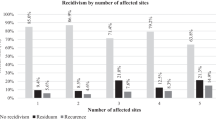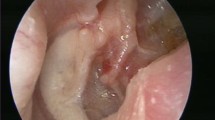Abstract
In this retrospective study, we analyzed the functional results after using the retrograde mastoidectomy technique for cholesteatoma removal in an adult patient population. The described technique was used at a tertiary referral center for cholesteatoma removal in 218 adult patients, representing 242 operated ears, with an average follow-up time of 20.3 months. With the retrograde mastoidectomy technique, the cholesteatoma is removed posteriorly through the canal wall, from the epitympanic region toward the mastoid, with the option to reconstruct the posterior bony canal wall or create an open mastoid cavity, depending on the size of the defect. Primary surgery was carried out in 58.7 % ears, with the remaining 41.3 % representing revision surgery. In 151 cases, the posterior canal wall was reconstructed, and in 91 cases a classical CWD with an open mastoid cavity was created. In the majority of the cases (n = 213, 88.0 %), a primary hearing restoration was performed. There were 18 recurrences (12.7 %) in primary cases and 22 recurrences (22 %) in revision surgeries. Ninety percent of the recurrences (36 of 40 cases) occurred within 5 years. A postoperative air-bone gap of less than 20 dB was achieved in 61.6 % of the operated ears. Ears with a reconstructed posterior canal wall had significantly better hearing results than those cases in which a CWD procedure was used (air-bone gap of 17.6 versus 22.5 dB, p < 0.05). The retrograde mastoidectomy technique for cholesteatoma removal resulted in satisfying hearing results in the majority of the cases, with a recurrence rate comparable to the current literature.

Similar content being viewed by others
References
Aslan Felek S, Islam A, Celik H et al (2009) The functional and anatomical results of the canal wall down tympanoplasty in extensive cholesteatoma. Acta Otolaryngol 129:1388–1394
Dornhoffer JL (2004) Retrograde mastoidectomy with canal wall reconstruction: a follow-up report. Otol Neurotol 25:653–660
Grewal DS, Hathiram BT, Saraiya SV (2007) Canal wall down tympanomastoidectomy: the ‘on-disease’ approach for retraction pockets and cholesteatoma. J Laryngol Otol 121:832–839
Haginomori S, Takamaki A, Nonaka R et al (2009) Postoperative aeration in the middle ear and hearing outcome after canal wall down tympanoplasty with soft-wall reconstruction for cholesteatoma. Otol Neurotol 30:478–483
Roth TN, Haeusler R (2009) Inside-out technique cholesteatoma surgery: a retrospective long-term analysis of 604 operated ears between 1992 and 2006. Otol Neurotol 30:59–63
Sanna M, Facharzt AA, Russo A et al (2009) Modified Bondy’s technique: refinements of the surgical technique and long-term results. Otol Neurotol 30:64–69
Stankovic M (2007) Follow-up of cholesteatoma surgery: open versus closed tympanoplasty. ORL J Otorhinolaryngol Relat Spec 69:299–305
Jansen C (1968) The combined approach for tympanoplasty (report on 10 years’ experience). J Laryngol Otol 82:779–793
Tos M (1995) Classic intact canal wall mastoidectomy. In: Tos M (ed) Manual of middle ear surgery, vol 2., Mastoid surgery and reconstructive proceduresThieme, Stuttgart New York, pp 106–155
Mcrackan TR, Abdellatif WM, Wanna GB et al (2011) Evaluation of second look procedures for pediatric cholesteatomas. Otolaryngol Head Neck Surg 145:154–160
Mishiro Y, Sakagami M, Kitahara T et al (2008) The investigation of the recurrence rate of cholesteatoma using Kaplan-Meier survival analysis. Otol Neurotol 29:803–806
Chang CC, Chen MK (2000) Canal-wall-down tympanoplasty with mastoidectomy for advanced cholesteatoma. J Otolaryngol 29:270–273
Bizakis JG, Chimona TS, Hajiioannou JK et al (2006) Canal wall down mastoidectomy for cholesteatoma: experience at the University of Crete. J Otolaryngol 35:48–52
Hakuba N, Hato N, Shinomori Y et al (2002) Labyrinthine fistula as a late complication of middle ear surgery using the canal wall down technique. Otol Neurotol 23:832–835
Deveze A, Rameh C, Puchol MS et al (2010) Rehabilitation of canal wall down mastoidectomy using a titanium ear canal implant. Otol Neurotol 31:220–224
Dornhoffer JL (2000) Retrograde mastoidectomy with canal wall reconstruction: a single-stage technique for cholesteatoma removal. Ann Otol Rhinol Laryngol 109:1033–1039
Plester D, Hildmann H, Steinbach E (1989) Atlas der Ohrchirurgie. Kohlhammer, Stuttgart
Hildmann H (1991) Open or closed technique of tympanoplasty. Comments on saving the posterior wall of the auditory canal. Laryngorhinootologie 70:335–339
(1995) Committee on Hearing and Equilibrium Guidelines for the Evaluation of Results of Treatment of Conductive Hearing Loss. American Academy of Otolaryngology-Head and Neck Surgery Foundation I Otolaryngol Head Neck Surg 113:186–187
Hildmann H, Sudhoff H, Jahnke K (2004) Principles of an individual approach to cholesteatoma surgery. In: Jahnke K (ed) Current topics in otolaryngology-head and neck surgery. middle ear surgery. recent advances and future directions. Thieme, New York, pp 73–93
Dornhoffer JL (2006) Cartilage tympanoplasty. Otolaryngol Clin North Am 39:1161–1176
Cody DT, Mcdonald TJ (1984) Mastoidectomy for acquired cholesteatoma: follow-up to 20 years. Laryngoscope 94:1027–1030
Hinohira Y, Yanagihara N, Gyo K (2007) Improvements to staged canal wall up tympanoplasty for middle ear cholesteatoma. Otolaryngol Head Neck Surg 137:913–917
Nyrop M, Bonding P (1997) Extensive cholesteatoma: long-term results of three surgical techniques. J Laryngol Otol 111:521–526
Haginomori S, Takamaki A, Nonaka R et al (2008) Residual cholesteatoma: incidence and localization in canal wall down tympanoplasty with soft-wall reconstruction. Arch Otolaryngol Head Neck Surg 134:652–657
Smyth GD, Dowe AC (1971) Cartilage canalplasty. Laryngoscope 81:786–792
Perkins R (1976) Tympanomastoid reconstruction: an operative procedure for anatomical and functional restoration of the radicalized ear. Laryngoscope 86:416–430
Migirov L, Tal S, Eyal A et al (2009) MRI, not CT, to rule out recurrent cholesteatoma and avoid unnecessary second-look mastoidectomy. Isr Med Assoc J 11:144–146
Profant M, Slavikova K, Kabatova Z et al (2012) Predictive validity of MRI in detecting and following cholesteatoma. Eur Arch Otorhinolaryngol 269:757–765
Koitschev A, Behringer P, Bogner D et al. (2012) Does diffusion-weighted MRI (DW-MRI) change treatment strategy in pediatric cholesteatoma? Acta Otolaryngol
Black B (2003) Reporting results in ossiculoplasty. Otol Neurotol 24:534–542
Neudert M, Zahnert T, Lasurashvili N et al (2009) Partial ossicular reconstruction: comparison of three different prostheses in clinical and experimental studies. Otol Neurotol 30:332–338
Stankovic MD (2008) Audiologic results of surgery for cholesteatoma: short- and long-term follow-up of influential factors. Otol Neurotol 29:933–940
Conflict of interest
None.
Author information
Authors and Affiliations
Corresponding author
Rights and permissions
About this article
Cite this article
Minovi, A., Venjacob, J., Volkenstein, S. et al. Functional results after cholesteatoma surgery in an adult population using the retrograde mastoidectomy technique. Eur Arch Otorhinolaryngol 271, 495–501 (2014). https://doi.org/10.1007/s00405-013-2452-x
Received:
Accepted:
Published:
Issue Date:
DOI: https://doi.org/10.1007/s00405-013-2452-x




